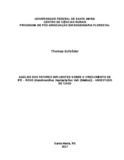| dc.creator | Schröder, Thomas | |
| dc.date.accessioned | 2018-06-05T14:42:28Z | |
| dc.date.available | 2018-06-05T14:42:28Z | |
| dc.date.issued | 2017-01-20 | |
| dc.identifier.uri | http://repositorio.ufsm.br/handle/1/13305 | |
| dc.description.abstract | Red Lapacho is timber species with largest market value, considered along with
Mahogany, as 'green gold' in areas of natural forest logging. Therefore, the objective of
this study was to analyze the different factors that influence the growth of this species,
taking into consideration the spatial and temporal dependence inherent to the data. A
census of Red Lapacho individuals was carried out in a natural fragment of Subtropical
Deciduous Forest with approximately 13 hectares of area. Quantitative morphological
and diameter increment data were obtained for each tree of this species. Competitors
defined by Bitterlich plots were measured and identified, and a regular grid with infill
points of soil sampling were also analyzed. Spatial patterns of distribution of Red
Lapacho and its dimensions had completely spatial randomness patterns. Sampled
species richness from competitors was of 60 species and the competition generated by
them had a random spatial pattern as well. A model for the height – diameter
relationship using Generalized Additive Mixed Models (GAMM) produced better results
when the latent spatial pattern was included in the model. The spatial patterns of nutrient
availability were influenced by relief of the area and distance from the edge of the forest
and grassland environments. Anionic nutrients were strongly influenced by the spatial
dynamics of the two vegetation types while cations were influenced mainly by
pedogenesis. The spatio-temporal Bayesian diameter increment model developed for
the Red Lapacho trees showed that there was considerable inter – annual variation in
tree growth. The spatial variation in tree growth was closely related to the pedogenesis
of the area under study, more specifically, lower increments were observed in areas
where the soil had signals of water influence in tits formation. Using site proxies based
on geocentric, phytocentric and dendrocentric approaches was able to take into
consideration the spatial variation in the growth of Red Lapacho trees and, all
approaches may be utilized in the development of growth models. | eng |
| dc.description.sponsorship | Conselho Nacional de Pesquisa e Desenvolvimento Científico e Tecnológico - CNPq | por |
| dc.language | por | por |
| dc.publisher | Universidade Federal de Santa Maria | por |
| dc.rights | Attribution-NonCommercial-NoDerivatives 4.0 International | * |
| dc.rights.uri | http://creativecommons.org/licenses/by-nc-nd/4.0/ | * |
| dc.subject | Relação hipsométrica | por |
| dc.subject | Efeito de borda | por |
| dc.subject | Sítio florestal | por |
| dc.subject | Height-diameter relationship | eng |
| dc.subject | Edge effects | eng |
| dc.subject | Forest site | eng |
| dc.title | Análise dos fatores influentes sobre o crescimento de ipê – roxo (Handroanthus heptaphyllus Vell. (Mattos)) – um estudo de caso | por |
| dc.title.alternative | Analysis of factors influencing the growth of red lapacho (Handroanthus heptaphyllus vell. (Mattos)) – a case study | eng |
| dc.type | Tese | por |
| dc.description.resumo | O Ipê – Roxo é uma das espécies de madeira com maior valor de mercado, sendo
considerado, juntamente com o Mogno, o 'ouro verde' em áreas de exploração de
florestas naturais. Assim sendo, o objetivo deste estudo foi analisar os diferentes fatores
que influem no crescimento desta espécie, levando em consideração a dependência
espacial e temporal inerente aos dados. Foi realizado um censo dos indivíduos de Ipê –
Roxo em um fragmento natural de Floresta Estacional Decidual com aproximadamente
13 hectares. Foram levantados dados morfométricos e de incremento em diâmetro de
cada uma das árvores desta espécie. Os competidores definidos por parcelas de
Bitterlich foram medidos e identificados e, uma grade regular com pontos de
preenchimento para amostras de solo foram avaliados. Os padrões espaciais de
distribuição das árvores de Ipê – Roxo e suas dimensões se adequaram à completa
aleatoriedade espacial. A riqueza de espécies amostradas como competidores foi de 60
espécies e a competição por estas gerada também teve padrão espacial aleatório. A
modelagem da relação hipsométrica das árvores utilizando Generalized Additive Mixed
Models (GAMM) obteve melhor ajuste quando o padrão espacial latente foi incluso no
modelo. Os padrões espaciais de disponibilidade dos nutrientes foram afetados pelo
relevo da área e pela distância da borda dos ambientes florestal e campestre.
Nutrientes aniônicos foram fortemente influenciados pela dinâmica espacial entre os
dois tipos vegetais enquanto cátions foram influenciados principalmente pelo processo
pedogênico. O modelo espaço – temporal Bayesiano de incremento em diâmetro
desenvolvido para as árvores de Ipê – Roxo mostrou que existe considerável variação
inter - anual do crescimento. A variação espacial do crescimento também se mostrou
relacionada com o processo pedogênico da área sob estudo, sendo que menores
incrementos foram observados em áreas onde o solo apresentou sinais de
hidromorfismo. A utilização de estimadores de sítio baseados em índices geocêntricos,
fitocêntricos e dendrocêntricos foi capaz de levar em consideração a variação espacial
do crescimento de árvores de Ipê – Roxo e, todos podem ser utilizados para a
construção de modelos de crescimento. | por |
| dc.contributor.advisor1 | Fleig, Frederico Dimas | |
| dc.contributor.advisor1Lattes | http://lattes.cnpq.br/4578837964834013 | por |
| dc.contributor.referee1 | Minella, Jean Paolo Gomes | |
| dc.contributor.referee1Lattes | http://lattes.cnpq.br/3194231720402587 | por |
| dc.contributor.referee2 | Pereira, Joao Eduardo da Silva | |
| dc.contributor.referee2Lattes | http://lattes.cnpq.br/2007149055930638 | por |
| dc.contributor.referee3 | Pikart, Tiago Georg | |
| dc.contributor.referee3Lattes | http://lattes.cnpq.br/5944914127634331 | por |
| dc.contributor.referee4 | Tonini, Helio | |
| dc.contributor.referee4Lattes | http://lattes.cnpq.br/9255737430748882 | POR |
| dc.creator.Lattes | http://lattes.cnpq.br/5762100423757678 | por |
| dc.publisher.country | Brasil | por |
| dc.publisher.department | Recursos Florestais e Engenharia Florestal | por |
| dc.publisher.initials | UFSM | por |
| dc.publisher.program | Programa de Pós-Graduação em Engenharia Florestal | por |
| dc.subject.cnpq | CNPQ::CIENCIAS AGRARIAS::RECURSOS FLORESTAIS E ENGENHARIA FLORESTAL | por |
| dc.publisher.unidade | Centro de Ciências Rurais | por |



